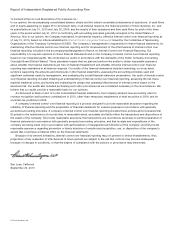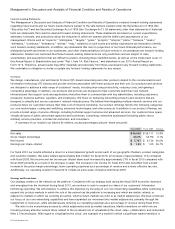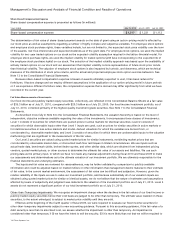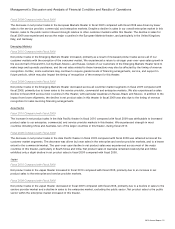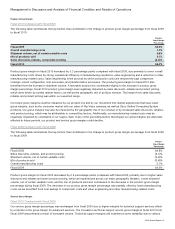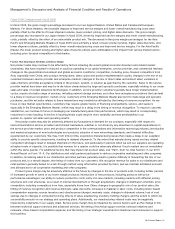Cisco 2010 Annual Report Download - page 17
Download and view the complete annual report
Please find page 17 of the 2010 Cisco annual report below. You can navigate through the pages in the report by either clicking on the pages listed below, or by using the keyword search tool below to find specific information within the annual report.Management’s Discussion and Analysis of Financial Condition and Results of Operations
sell the security before recovery of its entire amortized cost basis, or (iii) we do not expect to recover the entire amortized cost of
the security. If an impairment is considered other than temporary based on (i) or (ii) described in the prior sentence, the entire
difference between the amortized cost and the fair value of the security is recognized in earnings. If an impairment is considered
other than temporary based on condition (iii), the amount representing credit losses, defined as the difference between the present
value of the cash flows expected to be collected and the amortized cost basis of the debt security, will be recognized in earnings
and the amount relating to all other factors will be recognized in other comprehensive income (OCI). In estimating the amount and
timing of cash flows expected to be collected, we consider all available information including past events, current conditions, the
remaining payment terms of the security, the financial condition of the issuer, expected defaults, and the value of underlying
collateral.
For publicly traded equity securities, we consider various factors in determining whether we should recognize an impairment
charge, including the length of time and extent to which the fair value has been less than our cost basis, the financial condition and
near-term prospects of the issuer, and our intent and ability to hold the investment for a period of time sufficient to allow for any
anticipated recovery in market value.
There were no impairment charges on investments in fixed income securities and publicly traded equity securities that were
recognized in earnings in fiscal 2010, while for fiscal 2009 impairment charges of $258 million were recognized in earnings. There
were no such impairments in fiscal 2008. Our ongoing consideration of all the factors described previously could result in additional
impairment charges in the future, which could adversely affect our net income.
We also have investments in privately held companies, some of which are in the startup or development stages. As of July 31,
2010, our investments in privately held companies were $756 million, compared with $709 million as of July 25, 2009, and were
included in other assets. See Note 5 to the Consolidated Financial Statements. We monitor these investments for events or
circumstances indicative of potential impairment and will make appropriate reductions in carrying values if we determine that an
impairment charge is required, based primarily on the financial condition and near-term prospects of these companies. These
investments are inherently risky because the markets for the technologies or products these companies are developing are typically
in the early stages and may never materialize. Our impairment charges on investments in privately held companies were $25 million,
$85 million, and $12 million in fiscal 2010, 2009, and 2008, respectively.
Goodwill and Purchased Intangible Asset Impairments
Our methodology for allocating the purchase price relating to purchase acquisitions is determined through established valuation
techniques. Goodwill represents a residual value as of the acquisition date which, in most cases, results in measuring goodwill as
an excess of the purchase consideration transferred plus the fair value of any noncontrolling interest in the acquired company over
the fair value of net assets acquired, including contingent consideration. We perform goodwill impairment tests on an annual basis
in the fourth fiscal quarter and between annual tests in certain circumstances for each reporting unit. Effective in fiscal 2010, the
assessment of fair value for goodwill and purchased intangible assets is based on factors that market participants would use in an
orderly transaction in accordance with the new accounting guidance for the fair value measurement of nonfinancial assets.
The goodwill recorded in the Consolidated Balance Sheets as of July 31, 2010 and July 25, 2009 was $16.7 billion and $12.9
billion, respectively. In response to changes in industry and market conditions, we could be required to strategically realign our
resources and consider restructuring, disposing of, or otherwise exiting businesses, which could result in an impairment of
goodwill. There was no impairment of goodwill in fiscal 2010, 2009, or 2008. The excess of the fair value over the carrying value
for each of our reporting units ranged from approximately $4 billion for the Japan theater to approximately $41 billion for the United
States and Canada theater. We performed a sensitivity analysis for goodwill impairment with respect to each of our respective
reporting units and determined that a hypothetical 10% decline in the fair value of each reporting unit as of July 31, 2010 would not
result in an impairment of goodwill for any reporting unit.
We make judgments about the recoverability of purchased intangible assets with finite lives whenever events or changes in
circumstances indicate that an impairment may exist. Recoverability of purchased intangible assets with finite lives is measured by
comparing the carrying amount of the asset to the future undiscounted cash flows the asset is expected to generate. We review
indefinite-lived intangible assets for impairment annually or whenever events or changes in circumstances indicate the carrying
value may not be recoverable. Recoverability of indefinite-lived intangible assets is measured by comparing the carrying amount of
the asset to the future discounted cash flows the asset is expected to generate. If the asset is considered to be impaired, the
amount of any impairment is measured as the difference between the carrying value and the fair value of the impaired asset.
Assumptions and estimates about future values and remaining useful lives of our purchased intangible assets are complex and
subjective. They can be affected by a variety of factors, including external factors such as industry and economic trends, and
internal factors such as changes in our business strategy and our internal forecasts. We recorded impairment charges of $28
million, $95 million and $33 million during fiscal 2010, 2009 and 2008, respectively, related to our purchased intangible assets. Our
ongoing consideration of all the factors described previously could result in additional impairment charges in the future, which could
adversely affect our net income.
2010 Annual Report 15



